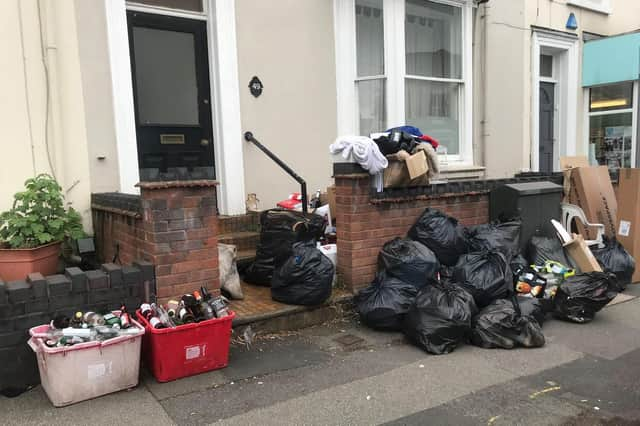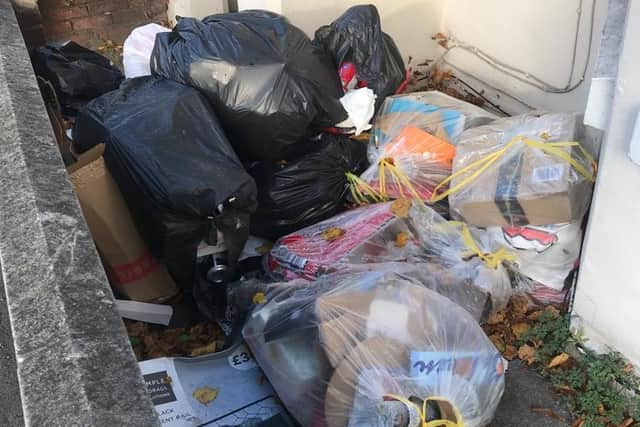Viewpoint: Why Leamington's rubbish problem will only get worse - and how we can tackle it


Rubbish is an ongoing problem in South Leamington - and action group Leamington Together believe it will only get worse with the council's new three-weekly rubbish collection service. Here, the group explains the issues facing local residents - and what should be done.
What a load of rubbish!
Warwick District Council’s (WDC's) announcement that from summer 2022 its new ‘123+’ waste management regime will mean a three-weekly refuse collection, is causing great consternation amongst the resident communities of CV31 and CV32. As the existing weekly service is clearly struggling with the sheer volume of rubbish already being produced, we are all wondering how the new contract is going to cope.


Public health hazard
Advertisement
Hide AdAdvertisement
Hide AdWith huge numbers of students living in high density concentrations throughout these postcodes, comprising up to one in five of the population, and outnumbering permanent residents on many streets, excess waste is fast becoming a public health hazard.
It goes without saying that a household of eight adults in a property originally designed for four, means at least double the amount of rubbish, but probably a lot more than that, as children produce less waste than adults. The refuse collectors have told us that in their experience Leamington produces 10 times the volume of waste during term-time than it does during vacation periods in these densely populated areas, and they should know! So, 20 per cent of the population is producing 90 per cent of the rubbish, the removal of which is being paid for by the other 80 per cent of residents.
Abandoned heaps of detritus
What is indisputable, is that landlords are using student accommodation as revenue generators and as such utilise every square metre of the property for its rentable value.
Storage space for waste is non-existent in many properties and, in addition, many students seem hazy (at best) about how to dispose of waste and on which days it's collected. The situation is further exacerbated at the beginning of term by deliveries of large items from IKEA and other furniture suppliers, which adds to the problem with vast amounts of packaging. And, at year end, we are all well acquainted with the abandoned heaps of detritus on our pavements, often featuring perfectly re-usable kitchen utensils, duvets and other homeware, which signal the end of term exodus, before the cycle starts again.
Fly-tipping
Advertisement
Hide AdAdvertisement
Hide AdFor those of us who live locally, fly-tipping and the accumulation of huge quantities of waste on the curtilages of the properties (to avoid fly-tipping fines) are now part of our street ‘scenery’. The latter, once ensconced in those 'off-street' areas, often remains for weeks on end, because it isn't a) in the right place and b) in the right configuration for collection.
Since fly-tipping has now been reduced to a ten day rather than a three-day removal regime, the prospect of clean, rubbish-free streets is becoming ever more unattainable.
Growing rat population
The future is looking bleak. The dawn of the council’s money-saving ‘123+’ programme will surely herald an enormous and hazardous waste situation with vast accumulations of fly-tipping and rubbish on the margins of HMO properties around town. The inevitable accompaniment to the rubbish crisis is of course the growing rat population much to the delight of local pest control companies, at least one of which has a permanent contract with an HMO landlord.
Dramatically different profile
It is patently obvious that the ‘123+’ scheme is not designed for areas characterised by densely packed transient populations like Leamington. It may work in Stratford, which has a dramatically different demographic and socioeconomic profile of ageing owner occupiers living in low density distribution in family homes, but is evidently not fit for purpose in this town.
What is the solution?
Advertisement
Hide AdAdvertisement
Hide AdThe solution seems obvious, if the political will is present to make it happen. Landlords are not providing an altruistic service for students. They are making serious money from their investments. A typical HMO in CV32’s Clarendon Avenue, for example, is rented to eight students for £37,000 on an eleven-month contract. According to the Housing Act (2004), landlords holding HMO licenses are 100 per cent responsible for the disposal of rubbish and “must make such further arrangements for the final disposal of refuse and litter from the HMO as may be necessary, either in default of previous/existing occupants, having regard to any service for such disposal provided by the council”.
Other businesses in town have to pay for commercial waste disposal. Landlords should too.
Such an initiative has been successfully rolled out in Bournemouth, so why not here? If WDC doesn't wake up to its responsibilities and its accountability to protect the quality of life of its council tax paying residents, we can probably look forward to a re-enactment of the Pied Piper of Hamelin here in Warwickshire in the not too distant future.